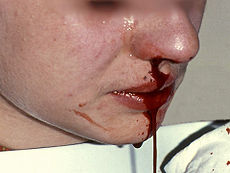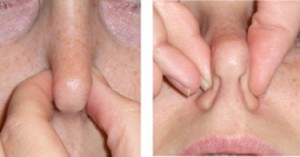Epistaxis is a condition characterized by bleeding from the nose and affects many individuals, especially children aged between 2 and 10 years. Get detailed information about the disease, including its causes, symptoms, diagnosis, and treatment options.
What is Epistaxis?
Page Contents
- 1 What is Epistaxis?
- 2 Epistaxis Types
- 3 Epistaxis Incidence
- 4 Epistaxis Causes
- 5 Epistaxis Symptoms
- 6 Epistaxis Diagnosis
- 7 Epistaxis Treatment
- 8 Epistaxis Management
- 9 Epistaxis Recovery Time
- 10 Epistaxis Prognosis
- 11 Epistaxis Follow-up and Home Remedies
- 12 Epistaxis Prevention
- 13 Epistaxis and Nasal Spray
- 14 Epistaxis Differential Diagnosis
As aforesaid, it is a condition marked by bleeding from the nose. Epistaxis is the medical term for nosebleed and it is more commonly known by the latter name. It occurs when the membranes that line the inner nose are irritated or disturbed enough to result in abnormal bleeding.
Epistaxis Types
The disorder is classified into two types:
Picture 1 – Epistaxis
Anterior
This form is characterized by bleeding near the front of the nose of patients.
Posterior
It is marked by bleeding from the back or posterior region of the nose. It is usually more severe than the anterior type.
Epistaxis Incidence
Approximately 60% of the population is believed to suffer from the condition at some point in their lifetime. Around 6% would need medical treatment. Most of the sufferers of this disease are found to be in the age groups 2 to 10 years and 50 to 80 years. These are the peak ages of incidence for the condition. The disease affects both sexes equally.
Although around 60% of people are affected by this disease, less than 10% of sufferers seek medical attention to get treated.
Epistaxis Causes
The disorder may arise due to varied factors like:
Environmental causes
These include:
- Long-time inhalation of dry air
- Dry cold conditions (the symptoms increase during winter)
Medicinal factors
These involve side effects of:
- Anticoagulants such as Warfarin, platelet inhibitors and Aspirin
- Solvent inhalation, also known as Huffing
- Cocaine
- Topical antihistamines and corticosteroids
Local trauma
This includes:
- Foreign bodies
- Nose picking
- Nasal septum deviation
- Facial trauma
- Infections of the sinus or nose
Coagulopathies
These involve:
- AIDS
- Chronic alcohol abuse
- Liver disease
- Platelet disorders
- Renal failure
- Splenomegaly
- Thrombocytopenia
- Inherited coagulopathies, as in Haemophilia A & B and Von Willebrand disease
Iatrogenic factors
These comprise of:
- Nasotracheal intubation
- Nasogastric tube insertion
Vascular abnormalities
These constitute:
- Aneurysms
- Ateriovenous malformation
- Endometriosis
- Hereditary haemorrhagic telangiectasia
- Neoplasm
- Sclerotic vessels
- Septal perforation/deviation
Hypertension is also regarded as a cause of this disease, although rarely a direct causative factor. The disorder is found to be more common in hypertensive individuals. Prolonged hypertension leads to the fragility of blood vessels and is believed to give rise to this disease, although in rare cases.
If bleeding occurs from the nose after a heavy blow to the skull, it could be a sign of a fractured skull. The suffering individual should be immediately taken to a hospital.
Epistaxis Symptoms
The signs and symptoms of the disorder vary, depending on the type of it that a person suffers from.
Anterior Epistaxis Symptoms
In this case, blood oozes out of the front of the nose constantly or starts and stops at various intervals. The bleeding may occur from one or both nostrils of sufferers. Blood may also flow into the throat.
Posterior Epistaxis Symptoms
In the posterior form, blood oozes slowly or steadily out of the back of the nose. The bleeding may start or stop at various periods. The blood may flow back into the throat at times. People suffering from nosebleeding, especially in case of the posterior form, may lose blood rapidly.
Epistaxis Diagnosis
The disease is initially diagnosed with the aid of a simple physical observation. A physician generally makes a patient sit up and lean forward. This helps in analyzing the site as well as the rate of bleeding. The healthcare provider may check the blood pressure and pulse of the individual. In case a person loses a lot of blood and requires transfusion, a physician might take a blood sample to find out whether the person is suffering from anemia. It also helps him/her understand the type of the blood and whether it has the ability to clot.
Epistaxis Treatment
Most cases of this condition are mild in nature and can be addressed simply with first aid. When a person starts to bleed through the nose, he/she should sit straight and lean forward. This would prevent the passage of blood into the throat. The individual should also pinch the nose tightly between the first finger and the thumb, just under the nasal bones. The nose should be held like this for 10 minutes. This helps stop the bleeding in most cases.
After the bleeding stops, a saline nose drop or a saline nasal spray can be used to keep the nose moist. Patients should not blow their nose for several hours after the stoppage of bleeding. If the bleeding persists for over 20 minutes or fails to respond to first aid, a health care provider should be contacted.
A healthcare provider generally treats such cases by applying a nose drop (like Afrin or Neo-Synephrine) or by pressing a cotton ball soaked in Epinephrine for 5-10 minutes over the site of bleeding.
If the region starts bleeding again, a healthcare provider may soak the cotton ball with a stronger medicine and press it over the area for around 5 minutes. This would induce numbness and reduce the supply of blood to the nasal membrane temporarily.
Blood loss from the front of the nose usually stops following inching or application of pressure on the bleeding region. If this is found to be unsuccessful in remedying the condition, a physician/healthcare provider may induce numbness in the area and pack the nose with a special balloon or a strip of gauze (coated with Vaseline) to apply pressure onto the site.
Epistaxis Management
While suffering from this problem, an individual as well as those caring for him/her should maintain a calm attitude. Display of anxious behavior may scare the affected person and jeopardize the condition. Those around a patient should make him sit upright and lean forward slightly. The patient himself or a person caring for him should squeeze the bottom section of the nose for 10-20 minutes to stop the oozing out of blood.
The patient should spit out any blood out to avoid its entry into the throat. He or she should breathe through the mouth and spit out any saliva that prevents breathing freely. An ice pack should be pressed onto the site to put an end to bleeding. A saline spray should also be put to use after some time. If bleeding continues despite such measures, it is necessary to get in touch with a local healthcare provider.
Epistaxis Recovery Time
With proper treatment, most cases of nosebleeding stop within 10 minutes.
Epistaxis Prognosis
In case of heavy bleeding or too many episodes of Epistaxis, it is important to get in touch with a professional healthcare provider. The risk of mortality is rare. Morbidity is often the outcome of complications of packing.
Epistaxis Follow-up and Home Remedies
Nosebleeding should be properly followed up to avoid a recurrence or worsening of the problem. This involves adopting the following home remedial measures:
- Not taking hot showers, especially during warm weather conditions
- Not using cocaine
- Using a vaporizer or humidifier to add moisture to the air
- Avoiding smoking. Smoking dries out the nose and irritates it
- Avoiding straining, bending over or lifting heavy objects
- Consulting a physician about any medicines that are being used and supposed to be a cause of bleeding. The condition is found to be more frequent and severe in cases where individuals take Aspirin.
- Using a saline nasal spray, petroleum jelly or an ointment (suggested by a healthcare provider) to reduce nasal dryness
Epistaxis Prevention
Bleeding from the nose can be prevented by following these measures:
- Using a nasal spray or an ointment on the nasal septum, to keep it well-coated and moist
- Keeping the home moist with a humidifier or vaporizer
- Avoiding rubbing, picking, blowing the nose or any other activity that might injure the nasal membranes
- Limit the usage of medicines like Ibuprofen and Aspirin that can increase bleeding
- Adjust the dosage of your medicines, such as non-steroidal anti-inflammatory drugs (NSAIDs) and Warfarin, only under the supervision of your physician. Self-adjustment without proper knowledge might lead to the condition.
- Sneezing through an open mouth, and not the nose
- Avoiding inserting anything solid into the nose, including cotton applicators and even fingers
Epistaxis and Nasal Spray
Applying a saline nasal spray two to three times in each nostril a day can remedy the condition. Saline nasal sprays can be made at home or purchased over-the-counter. However, you can also create one at home. The steps to making a saline nasal spray at home are as follows:
Picture 2 – Epistaxis Image
- Get 1 quart of tap water.
- Add 1 tsp salt into it and combine well to form a uniform mixture.
- Boil the water for 15-20 minutes to free it of all impurities.
- Clean a bottle thoroughly and pour a little of the water into it for the purpose of disinfecting it. Throw out the water.
- Cool the remaining water until it comes down to a lukewarm temperature. Now pour it into the bottle and use as a spray.
Epistaxis Differential Diagnosis
The differential diagnosis of Epistaxis involves distinguishing the signs of the disorder from those of other conditions that give rise to similar symptoms. These include:
- Chemical irritants
- Dipyridamole toxicity
- Heparin toxicity
- Hepatic failure
- Leukemia
- Trauma
- Tumor
- Thrombocytopenia
- Ticlopidine toxicity
Following nosebleeding, patients should be treated and managed in as calm a manner as possible to reduce their anxiety. Epistaxis is not a complicated condition and can be cured with proper treatment and follow-up. Following treatment, it is important to adopt follow-up measures to make an effective recovery from the problem.
References:
Tan LK, Calhoun KH. Epistaxis. Med Clin North Am. 1999;83:43–56.
Randall DA; Epistaxis packing. Practical pointers for nosebleed control. Postgrad Med. 2006 Jun-Jul;119(1):77-82.


